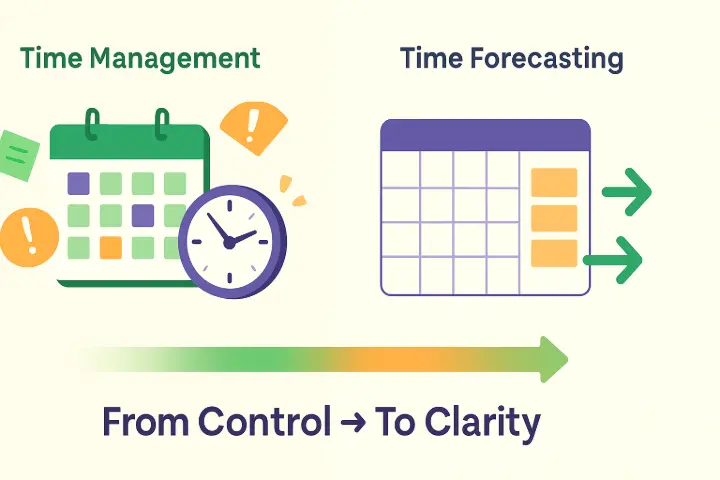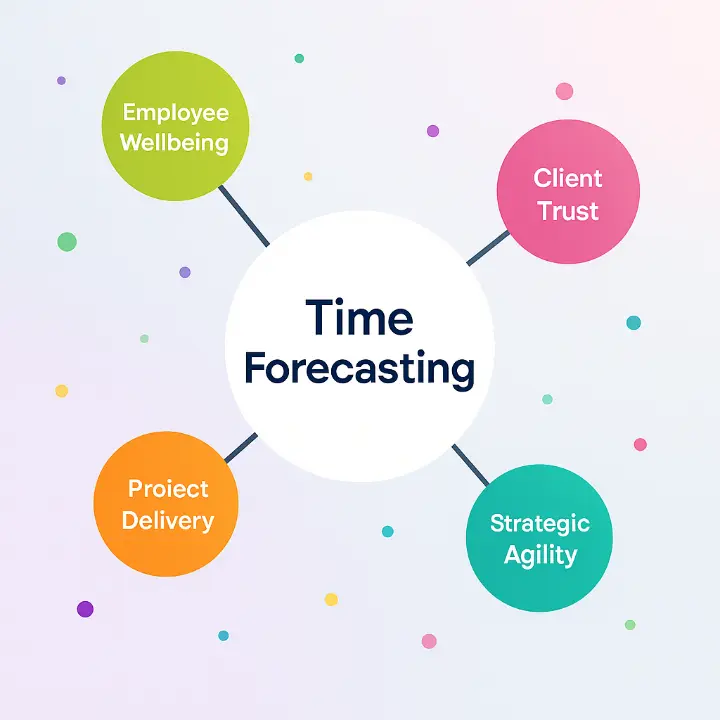For years, professionals have been told to “manage their time better.” Block your calendar. Prioritize tasks. Avoid distractions.
But the truth is, time management is reactive. It helps you optimize what already happened.
The real competitive edge; for individuals, teams and organizations comes from time forecasting.
The Problem With Traditional Time Management
Time management assumes two things:
- That your workload is predictable.
- That you can fit everything neatly into your day.
But leaders know those assumptions rarely hold true. Priorities shift mid-week. Unexpected fires need attention. Teams get overcommitted without realizing it.
Managing time after the fact is like managing your budget only after the money is spent.
Forecasting: A Different Mindset
Time forecasting flips the script. It’s about looking ahead and planning with visibility into:
- What’s already on your plate
- What’s coming up
- Where the risks or gaps lie
This isn’t about filling a calendar. It’s about aligning effort with strategy.
When you forecast time, you:
- Spot bottlenecks before they happen
- Balance workloads across teams
- Prevent overpromising to clients
- Make informed trade-offs
In short: you see problems before they become crises.
Why Leaders Need Time Forecasting
For leaders, forecasting isn’t about micromanaging tasks. It’s about capacity planning and bandwidth visibility.
- For managers: Who has capacity? Who’s overloaded? Can we commit to this project realistically?
- For executives: Where is the organization’s time actually going? Is it aligned with strategy, or lost in busywork?
Without forecasting, decisions are made in the dark. With it, leaders can allocate resources with confidence.

The Ripple Effect
Time forecasting does more than improve schedules:
- Employee wellbeing: Less overcommitment, less burnout.
- Client trust: Clearer expectations, fewer missed deadlines.
- Project delivery: Better alignment between effort and outcome.
- Strategic agility: Leadership can pivot without breaking teams.

How to Start Forecasting Your Time
Shifting from management to forecasting doesn’t require a complete overhaul. It starts with three simple steps:
-
Look ahead, not just back
- Instead of only logging hours, plan where your hours will go each week.
- Treat your calendar like a forecast, not a diary.
-
Visualize team capacity
- Use simple charts or tools to see who is under/over capacity.
- This prevents silent burnout and improves collaboration.
-
Align time with priorities
- Forecasting isn’t about doing more. It’s about doing the right things first.
- Connect time forecasts to business goals so teams see how their work ladders up.
Over time, this practice scales from individuals -> to teams -> to the entire organization.
Forecasting at Scale
At i8CLOUD, we’ve seen how time forecasting transforms productivity.
One of the most common challenges leaders share with us is:
“We don’t know if our team has bandwidth until it’s too late.”
That’s why we built the Time Forecasting App for Odoo.
It empowers employees to forecast their week, gives managers live capacity views, and provides leadership with strategic insights into how time is being spent.
This isn’t about timesheets after the fact. It’s about forecasting before work begins.
The Shift From Management to Forecasting
Here’s the mindset shift in one line:
- Time management is about control.
- Time forecasting is about clarity.
And clarity scales.
When individuals forecast, they work smarter.
When teams forecast, collaboration improves.
When leadership forecasts, the organization moves in sync.
Final Thought
In 2025, professionals don’t just need to manage time, they need to forecast it.
Because the future of work isn’t about squeezing more into the day.
It’s about aligning time with priorities, before the first hour is even spent.
At i8CLOUD, we believe this shift is essential. That’s why we’ve built tools and practices, to help companies move from time tracking to time forecasting.
📩 Want to see how forecasting could transform your team’s productivity?
Check out our app here: 👉 Timesheet Forecasting